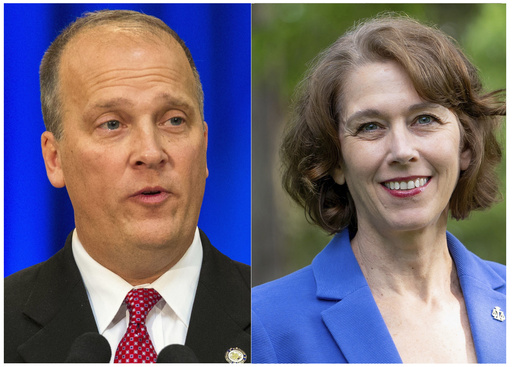MADISON, Wis. — A recent political advertisement impacting Wisconsin’s closely watched Supreme Court election has sparked controversy for featuring a manipulated image of the liberal candidate, Susan Crawford. Her campaign argues that this could potentially breach a newly enacted state regulation.
The ad in question has been funded by Brad Schimel’s campaign, who is Crawford’s opponent and currently serves as a circuit court judge in Waukesha County. The outcome of the election scheduled for April 1 holds significant weight, as it could either maintain the liberal majority in the Wisconsin Supreme Court or shift it towards a conservative stance.
In the ad, Crawford’s image appears in black and white, displaying her with her lips tightly sealed, which contrasts sharply with a vibrant photo from her 2018 campaign for Dane County Circuit Court where she is seen smiling broadly. Crawford’s representatives have accused Schimel’s campaign of altering her image, suggesting it may violate a law established last year. This statute, which garnered bipartisan support and was signed into law by Democratic Governor Tony Evers, mandates that political advertisements disclose any usage of audio or visual content generated by artificial intelligence. Noncompliance with this disclosure requirement could lead to a fine of up to $1,000.
Crawford’s spokesperson, Derrick Honeyman, criticized Schimel’s tactics, indicating that these manipulations reflect his desperation to deflect attention from his own ineffective record. In defense, Schimel’s campaign spokesperson Jacob Fischer acknowledged that the image had been “edited,” but asserted it had not been created using AI.
Peter Loge, who heads the Project on Ethics in Political Communication at George Washington University, expressed that altering images to mislead the public is unethical. Nevertheless, he mentioned that in the context of political advertising, the level of manipulation in the Schimel advertisement might not be the most egregious example. He recalled past instances of doctored images used in political promotions, including a notable case where a political action committee in 2015 displayed a fabricated image of former President Barack Obama with Iranian President Hassan Rouhani, which never occurred.
Additionally, in the upcoming Indiana governor’s race, a manipulated image also surfaced last year. Loge advised caution when assessing such media, asserting that just because an image is presented in a commercial or online does not affirm its authenticity.
The ad launched by Schimel’s campaign accuses Crawford of negligence regarding the release of a convicted rapist in 2001, suggesting that her failure to timely file an appeal allowed the offender to evade justice. While Crawford led the department at that time, an attorney and two secretaries were ultimately responsible for the missed deadline, according to findings from the attorney general’s investigation. Schimel’s ad alleges, “Crawford didn’t bother filing the appeal in time, letting the rapist walk free.”
After realizing the mistake, Crawford took swift action by reviewing the deadlines for all pending appeals herself. Investigators from the Republican Party, including former state Rep. Scott Walker, who was then governor, indicated that the incident was isolated.
Schimel held the position of attorney general from 2015 to 2019 during Walker’s tenure. Following his defeat in the 2018 election, Schimel was appointed as a judge by Walker a day after losing his position.
This report was revised to clarify the date of the inmate’s release, correcting it to 2001 from the previously stated 2010.



